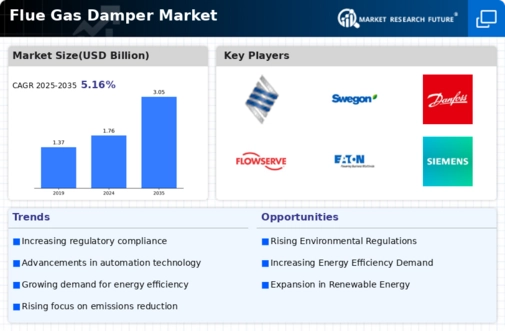Rising Energy Demand
The Global Flue Gas Damper Market Industry is poised for expansion due to the increasing global energy demand. As populations grow and economies develop, the need for energy production intensifies, leading to a rise in power generation facilities. This surge in energy production necessitates the use of flue gas dampers to optimize efficiency and reduce emissions. For example, countries like India and China are investing heavily in new power plants, which often incorporate advanced flue gas management systems. This trend is expected to contribute to a compound annual growth rate of 5.12% from 2025 to 2035, further solidifying the market's position.
Market Growth Projections
The Global Flue Gas Damper Market Industry is projected to experience substantial growth over the next decade. With a market size anticipated to reach 1.76 USD Billion in 2024 and further expanding to 3.05 USD Billion by 2035, the industry is poised for a robust trajectory. This growth is underpinned by a compound annual growth rate of 5.12% from 2025 to 2035, indicating a strong demand for flue gas management solutions. The increasing emphasis on environmental compliance, energy efficiency, and technological advancements will likely drive this upward trend, positioning the industry favorably in the global market.
Focus on Energy Efficiency
The Global Flue Gas Damper Market Industry is increasingly influenced by the global focus on energy efficiency. Industries are under pressure to reduce energy consumption and emissions, prompting the adoption of technologies that enhance operational efficiency. Flue gas dampers play a crucial role in optimizing combustion processes, thereby improving energy utilization. For example, the implementation of advanced dampers in coal-fired power plants has demonstrated significant reductions in fuel consumption and emissions. This trend aligns with global sustainability goals, encouraging further investment in energy-efficient technologies, which is likely to bolster market growth in the coming years.
Technological Advancements
Technological innovations are significantly influencing the Global Flue Gas Damper Market Industry. The development of smart dampers equipped with sensors and automation capabilities enhances operational efficiency and reduces maintenance costs. These advancements allow for real-time monitoring and adjustments, optimizing the performance of flue gas systems. For instance, the integration of IoT technologies in flue gas dampers enables predictive maintenance, which minimizes downtime and operational disruptions. As industries increasingly adopt these technologies, the market is likely to benefit from enhanced product offerings and improved performance metrics, thereby attracting more investments.
Growth in Industrialization
The Global Flue Gas Damper Market Industry is benefiting from rapid industrialization across emerging economies. As countries like Brazil, Mexico, and Indonesia industrialize, there is a corresponding increase in manufacturing and energy production activities. This industrial growth necessitates the installation of flue gas dampers to manage emissions effectively. The demand for efficient energy systems in these regions is driving investments in flue gas management technologies. Consequently, the market is projected to grow, with estimates suggesting it could reach 3.05 USD Billion by 2035, reflecting the ongoing industrial expansion and the need for compliance with environmental standards.
Increasing Environmental Regulations
The Global Flue Gas Damper Market Industry is experiencing growth due to stringent environmental regulations aimed at reducing emissions from industrial processes. Governments worldwide are implementing policies that mandate the installation of effective emission control technologies, including flue gas dampers. For instance, the European Union's Industrial Emissions Directive emphasizes the need for advanced emission reduction systems. This regulatory landscape is likely to drive demand for flue gas dampers, as industries seek compliance with these regulations. As a result, the market is projected to reach 1.76 USD Billion in 2024, reflecting a growing emphasis on environmental sustainability.




















Leave a Comment